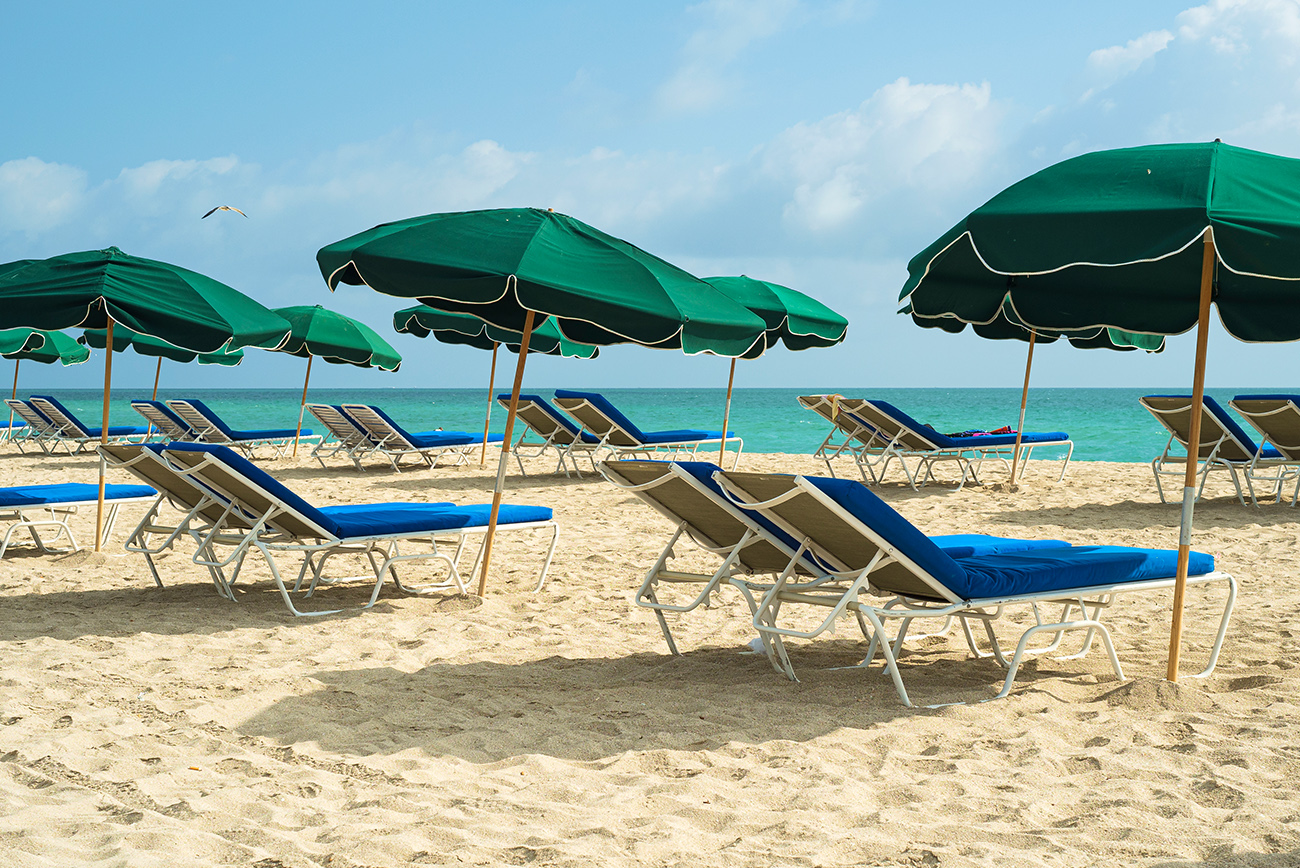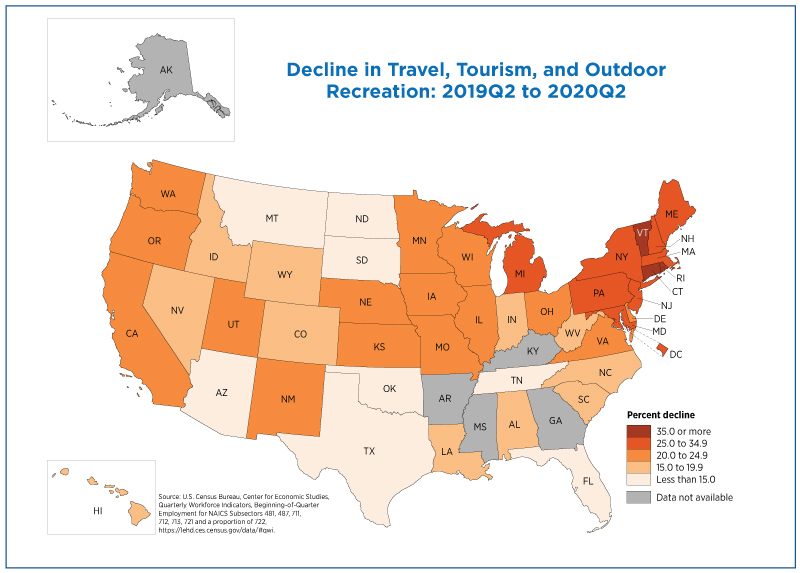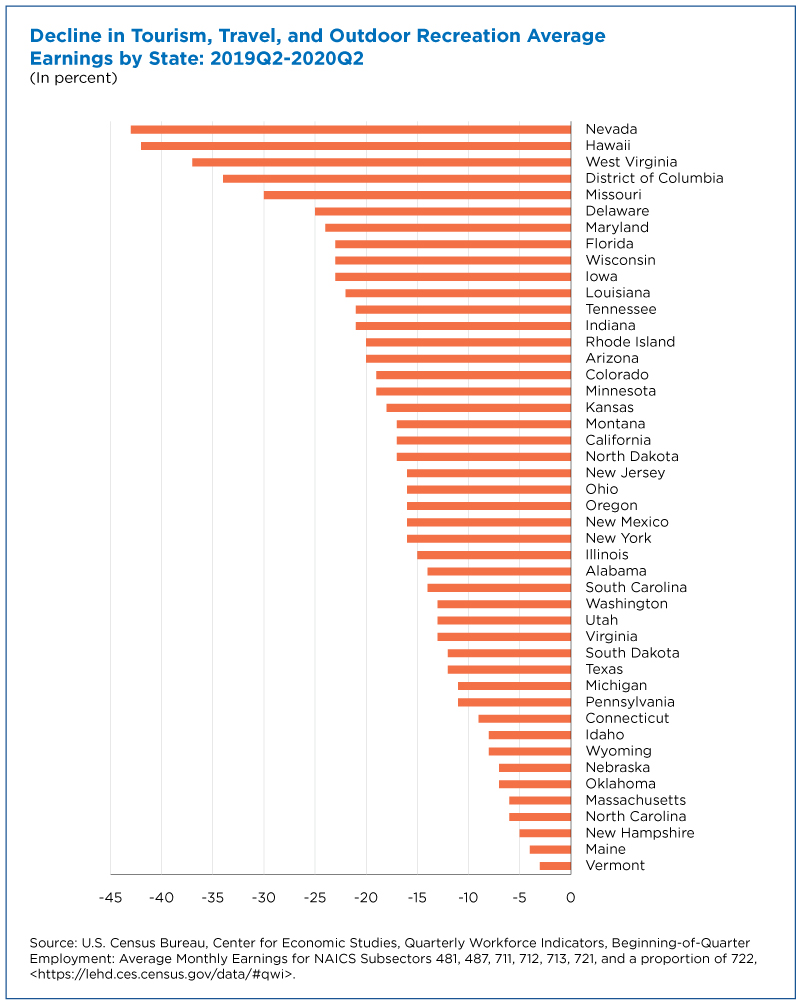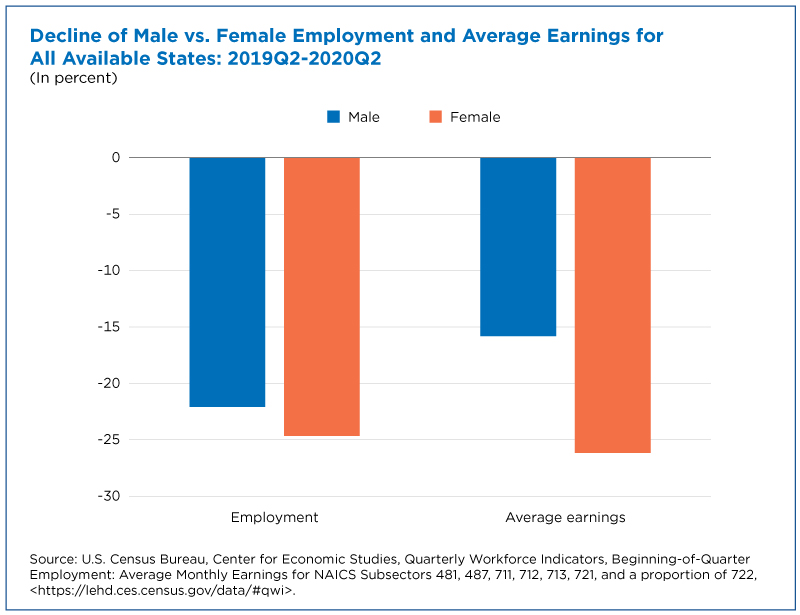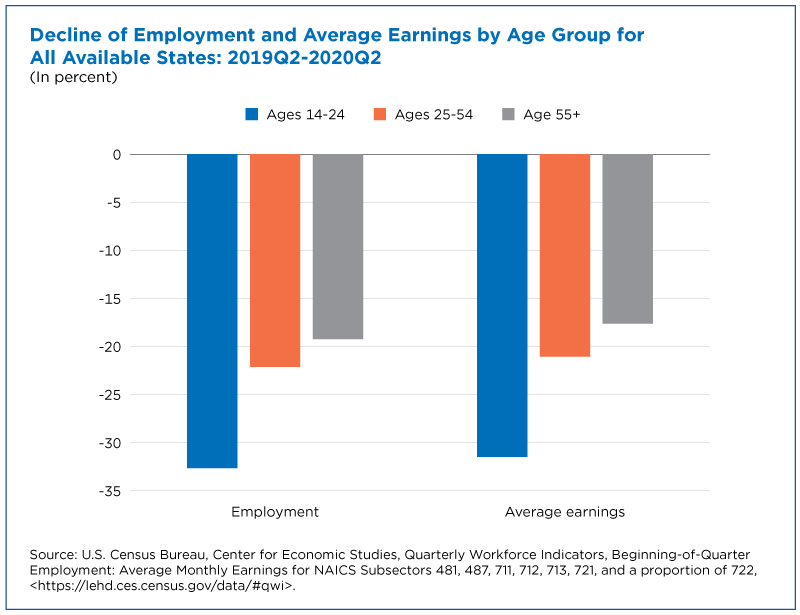Tourism and Related Industries Declined Sharply in Northeastern States in Spring 2020, Women and Young Workers More Affected Nationwide
Early outbreaks of COVID-19 affected large populations in New York and New Jersey in the spring of 2020, leading the Centers for Disease Control and Prevention (CDC) to issue a domestic travel advisory for those states.
In the rest of the country, the economy was already beginning to feel the economic impacts of the pandemic, especially on tourism and related industries that rely on people traveling.
Workers employed in travel, tourism and outdoor recreation at the beginning of the second quarter of 2020 also experienced significant earnings losses during the quarter (up to 40%) compared to those employed at the start of the second quarter of 2019.
Not surprisingly, regions with the most severe COVID-19 outbreaks and largest share of tourism jobs were disproportionately affected at the start of the pandemic and the Census Bureau’s Quarterly Workforce Indicators (QWI) show the extent of the employment and earnings impacts from state to state.
Travel, tourism and outdoor recreation jobs make up approximately 4%-5% of total private employment in most states. However, Hawaii and Nevada are outliers with much larger shares of 14.4% and 21.0% in the second quarter of 2019, respectively.
In addition to Nevada and Hawaii, Wyoming (7.3%), Montana (7.2%), and Florida (7.1%) make up the five states with the largest employment share in travel, tourism, and outdoor recreation.
Drop in Tourism at Onset of Pandemic
QWI data can be used to show year-over-year changes in travel, tourism and outdoor recreation employment. Note that we calculate year-over-year changes rather than quarterly changes due to the seasonality of these industries.
The states with the greatest declines in travel, tourism and outdoor recreation employment were Rhode Island (decline of 37.9%), Vermont (37.4%), Connecticut (36.4%), Massachusetts (32.1%), New York (31.5%), and Washington (24.9%).
These states reflect locations of initial outbreaks at the start of the pandemic and the disproportionate impact it had on and travel and tourism in these areas.
Earnings Losses in Tourism Jobs
Workers employed in travel, tourism and outdoor recreation at the beginning of the second quarter of 2020 also experienced significant earnings losses during the quarter (up to 40%) compared to those employed at the start of the second quarter of 2019.
These earnings losses reflect lost hours or weeks of work during the quarter as well as any layoffs later in the quarter. Again, impact on earnings varied widely across states.
States that saw the largest earnings decreases among these workers were Nevada (decline of 42.9%), Hawaii (41.9%), West Virginia (37.5%), the District of Columbia (34.3%), and Missouri (30.3%).
States with the largest employment losses, however, were not always the same states that saw the largest percentage earnings declines during this time period.
Female Workers More Affected
Women were more likely to lose either employment or earnings in the second quarter of 2020 relative to other workers in the industry.
Nationally, the share of female employment in travel, tourism and outdoor recreation was just over 50%, with some variation across states. However, women experienced larger employment and earnings declines than men.
Notably, the decline in average earnings for women was considerably more pronounced than the decline in employment at the beginning of the quarter.
Women accounted for well over 50% of travel, tourism and outdoor recreation job losses in most states and for more than 60% of employment losses in several states.
More Jobs, Earnings Losses for Young Workers
Young workers were more likely to lose either employment or earnings in the second quarter of 2020 relative to other workers in the industry.
The largest declines in both employment and earnings in these industries were among workers younger than 25 years old.
These young workers accounted for just under 20% of national employment in travel, tourism and outdoor recreation with some variation across states. Yet they typically accounted for a larger fraction of employment declines in some states.
In Florida, Pennsylvania, Texas and Virginia, for example, young workers accounted for up to 35% of the total decline in travel, tourism, and outdoor recreation employment. But they made up a smaller share of employment losses in Western states.
Workforce Dynamics Resources
The Center for Economic Studies (CES) manages the Local Employment Dynamics (LED) Partnership, a voluntary federal-state partnership that merges worker and employer data to produce enhanced labor market statistics used to research and report workforce dynamics.
In addition to the Quarterly Workforce Indicators (QWI), LED Partnership data include the Job-to-Job Flows (J2J), Post-Secondary Employment Outcomes (PSEO) and LEHD Origin-Destination Employment Statistics (LODES).
All are accessible online for public use at lehd.ces.census.gov/data/. The QWI, J2J, PSEO, and LODES data can be analyzed interactively in the QWI Explorer, J2J Explorer, PSEO Explorer and OnTheMap applications, respectively.
Story Ideas and Statistics
-
Stats for StoriesSummer 2023: June 21-September 23In the United States, summer 2023 begins with the Summer Solstice on June 21 at 10:58 a.m. EDT and ends with the Autumnal Equinox on Sept. 23 at 2:50 a.m. EDT.
-
Stats for StoriesGreat Outdoors Month: June 2023The 2016 National Survey of Fishing, Hunting, and Wildlife-Associated Recreation counted more than $157 billion in expenditures for wildlife-related recreation.
-
Stats for StoriesNational Hunting and Fishing Day: September 23, 2023The 2016 National Survey of Fishing, Hunting, and Wildlife-Associated Recreation found 35.8M anglers, 11.5M hunters, and 86.0M wildlife watchers spent $156.9B.
Subscribe
Our email newsletter is sent out on the day we publish a story. Get an alert directly in your inbox to read, share and blog about our newest stories.
Contact our Public Information Office for media inquiries or interviews.
-
America Counts StoryNot All Industries Experienced Declines During the PandemicJune 08, 2021Estimates from the Census Bureau’s Quarterly Services Survey show that some industries grew despite the pandemic while others saw declining revenue.
-
America Counts StoryEarly COVID Impact on U.S. Economy More Widespread Than on MortalityMarch 08, 2021Census Bureau research shows the pandemic initially had a more widespread impact on the economy than on mortality rates.
-
America Counts StoryRVs: A Way to See America From the Safety of Your Own “Home”September 29, 2020Americans embrace recreational vehicles as sales have grown steadily for years.
-
Business and EconomyEconomic Census Geographic Area Statistics Data Now AvailableApril 07, 2025A new data visualization based on the 2022 Economic Census shows the changing business landscape of 19 economic sectors across the United States.
-
Income and PovertyWhat Sources of Income Do People Rely On?April 02, 2025A new interactive data tool shows income sources for hundreds of demographic and economic characteristic combinations.
-
Business and EconomyBig Improvements to the Annual Integrated Economic Survey (AIES)March 26, 2025The Census Bureau is making several changes and enhancements to capture 2024 economic data based on feedback from last year’s survey.
-
PopulationOnly 50 U.S. Counties Had Populations Over a Million in 2024March 17, 2025A new data visualization highlights U.S. counties between 1970 and 2024 whose populations ever surpassed a million.


